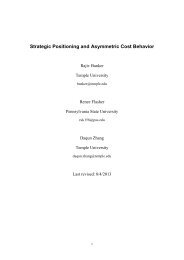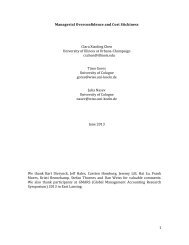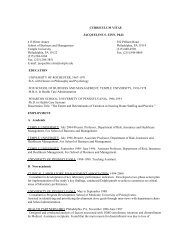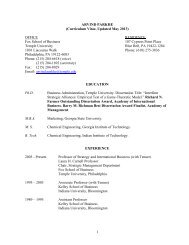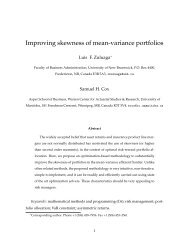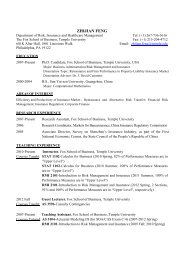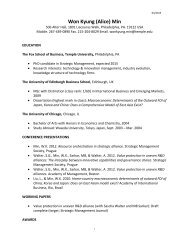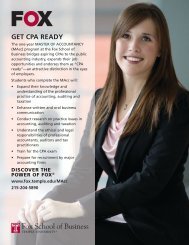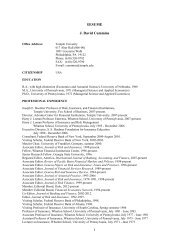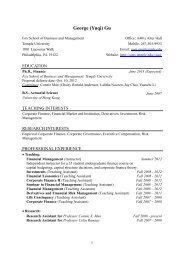Organizational Complexity and Succession Planning - Fox School of ...
Organizational Complexity and Succession Planning - Fox School of ...
Organizational Complexity and Succession Planning - Fox School of ...
You also want an ePaper? Increase the reach of your titles
YUMPU automatically turns print PDFs into web optimized ePapers that Google loves.
JOURNAL OF FINANCIAL AND QUANTITATIVE ANALYSIS VOL. 41, NO. 3, SEPTEMBER 2006COPYRIGHT 2006, SCHOOL OF BUSINESS ADMINISTRATION, UNIVERSITY OF WASHINGTON, SEATTLE, WA 98195<strong>Organizational</strong> <strong>Complexity</strong> <strong>and</strong> <strong>Succession</strong><strong>Planning</strong>Lalitha Naveen*AbstractThis study uses a large sample <strong>of</strong> firms to examine how human capital considerations affectthe process <strong>of</strong> CEO succession. Costs <strong>and</strong> benefits <strong>of</strong> succession planning are affected bya firm's level <strong>of</strong> operational complexity <strong>and</strong> human capital requirements; firms that aremore complex incur greater costs to transferring firm-specific knowledge <strong>and</strong> expertise toan outsider, <strong>and</strong> should be more likely to groom an internal c<strong>and</strong>idate for the CEO position.Consistent with this, I find that a firm's propensity to groom an internal c<strong>and</strong>idate for theCEO position is related to firm size, degree <strong>of</strong> diversification, <strong>and</strong> industry structure. Myresults also suggest that succession planning is associated with a higher probability <strong>of</strong>inside succession <strong>and</strong> voluntary succession <strong>and</strong> a lower probability <strong>of</strong> forced succession.I also provide evidence that horizon problems are mitigated to some extent by having asuccession plan.I. IntroductionHighly publicized CEO transitions at large firms such as AT&T <strong>and</strong> GE havecaptured the attention <strong>of</strong> academic scholars <strong>and</strong> the business media <strong>and</strong>, at thesame time, have highlighted the importance <strong>of</strong> CEO succession. Thus, it is quitenatural that some company boards demonstrate a strong interest in identifying <strong>and</strong>installing the right individual to replace the outgoing CEO. At Ralston Purina, forinstance, CEO William Stiritz was awarded optiotis estimated to be worth morethan $16 million contingent on his finding a suitable successor. At Abbott Labs,the board <strong>of</strong> directors ousted chairman <strong>and</strong> CEO Robert Schoellhom after he fired* Naveen, lalitha@gsu.edu, Department <strong>of</strong> Finance, J. Mack Robinson <strong>School</strong> <strong>of</strong> Business, GeorgiaState University, 35 Broad Street, Atlanta, GA 30303. 1 am grateful to Jeff Coles <strong>and</strong> Mike Lemmonfor providing valuable encouragement <strong>and</strong> advice. The paper has benefited greatly from their input. Ithank David Yermack (associate editor <strong>and</strong> referee) for suggestions that have significantly improvedthe paper. For helpful comments, I thank James Booth, Murillo Campello, Dan Deli, Michael Hertzel,Jayant Kale, Jonathan Karp<strong>of</strong>f (the editor), William Greene, Omesh Kini, Jim Linck, Robert Parrino,Tod Perry, Mike Rebello, Steve Smith, Kumar Venkataraman, <strong>and</strong>, especially, Naveen Daniel. Finally,1 am grateful to seminar participants at Arizona State University, Babson College, ColumbiaUniversity, the FMA Doctoral Student Symposium, the 2000 FMA Meeting, Georgia State University,Miami University, New York University, University <strong>of</strong> Missouri-Columbia, <strong>and</strong> Virginia Tech forseveral helpful suggestions. Earlier versions <strong>of</strong> this paper were entitled "Management Turnover <strong>and</strong><strong>Succession</strong> <strong>Planning</strong> in Firms."661
662 Journal <strong>of</strong> Financial <strong>and</strong> Quantitative Analysisthree successive presidents, all <strong>of</strong> whom were considered to be his potential successors.According to Spencer Stuart, an executive search firm, boards are tyingas much as one-third <strong>of</strong> the CEO's bonus to the development <strong>of</strong> k successionplan. CEO succession appears to be an important concern for the coi'-poration, itsshareholders, <strong>and</strong> its employees.jNevertheless, CEO succession as a process has received little explicit attentionin the finance literature. Instead, most contributions address tlje individualcomponents <strong>of</strong> CEO transitions such as the detemiinants <strong>of</strong> CEO turnover, thechoice between an inside <strong>and</strong> an outside successor, <strong>and</strong> the practice o'f combiningthe CEO <strong>and</strong> chairman positions.' Little research, however, has been devoted tostudying how these various components are part <strong>of</strong> any sort <strong>of</strong> deliberate processguiding CEO succession. This paper is a step toward underst<strong>and</strong>ing this importantdecision. Using a large sample <strong>of</strong> firms, I examine how human capit4l considerationsaffect the process <strong>of</strong> CEO succession in firms. iThe only work to this point focused directly on CEO succession is Vancil(1987), who bases his main conclusions on a small number <strong>of</strong> case studies. Vancilsuggests that one common pattern <strong>of</strong> succession is "relay succession." Thisprocess includes the selection <strong>of</strong> an heir apparent a few years before! the CEO isexpected to step down. The heir apparent <strong>and</strong> the incumbent CEO then work togetheruntil the latter steps down (usually to become chairman <strong>of</strong> the board) <strong>and</strong>the heir apparent takes over. In my study, I identify a firm as having an heir apparent<strong>and</strong>, therefore, a relay succession if the firm has a president or chief operating<strong>of</strong>ficer (COO) distinct from the CEO or chairman. ^ My analysis reveals severalinteresting findings.Eirst, I find that the relay process for CEO succession, as represented byVancil (1987), is used by a significant proportion <strong>of</strong> sample firms. Many firms inmy sample appear to plan for succession by designating a successor in anticipation<strong>of</strong> CEO turnover. Eor instance, four years before CEO turnover, 41% <strong>of</strong> firmshave an heir apparent. Immediately before turnover, this number junips to 60%.Because the relay model <strong>of</strong> succession appears to be common, the remainder <strong>of</strong>this analysis focuses on relay succession. To be sure, some firms rely on someother sort <strong>of</strong> process at the CEO level. Therefore, as a basis <strong>of</strong> comparison, Iuse a complementary subsample <strong>of</strong> firms including firms that use the horse racemodel exemplified by GE, firms with other, less well-defined processes, <strong>and</strong> firmswith no process at all,'Second, I find that relay succession is more likely in larger firms, more diversifiedfirms, <strong>and</strong> in certain industries where human capital is less easily transferableacross firms. In general, this set <strong>of</strong> results is consistent with sirriple notions<strong>of</strong> how operational complexity <strong>and</strong> human capital are likely to affect the benefitsversus costs <strong>of</strong> using the relay succession process. Several hypothe.ses are detailedin Section II, but the general idea is as follows. Eirm-specific human capital'See, for example, Warner, Watts, <strong>and</strong> Wruck (1988), Weisbach (1988), Agrawalj, Knoeber, <strong>and</strong>Tsoulouhas (2006), Cannella <strong>and</strong> Lubatkin (1993), Borokhovich, Parrino, <strong>and</strong> Trapani i;i997), Parrino(1997), Brickley, Coles, <strong>and</strong> Jarrell (1997), <strong>and</strong> Baliga, Moyer, <strong>and</strong> Rao (1996). |^For example, Vancil (1987), Cannella <strong>and</strong> Lubatkin (1993), <strong>and</strong> Dechow <strong>and</strong> SIcian (1991) suggestthat the president is the most likely person to become the next CEO. This is 'also supportedstrongly by anecdotal evidence (see the Appendix, which is available from the author, for some examples).I also use other proxies for this measure that I discuss in Section V.B. '
Naveen 663includes "expertise about a firm's products, customers, compedtors, <strong>and</strong> employees,as well as an informal network <strong>of</strong> people providing information <strong>and</strong> support"(Bonnier <strong>and</strong> Bruner (1989), p. 100). Also, in more complex firms the CEO needsa deep underst<strong>and</strong>ing <strong>of</strong> the geographical <strong>and</strong> product markets in which the firmcompetes <strong>and</strong> the synergies among the firm's various divisions. In many cases, itis likely that much <strong>of</strong> this expertise <strong>and</strong> knowledge base is applicable primarilyto that one firm, Further, it may be expensive to transfer knowledge <strong>and</strong> expertiseto an incoming outsider. Such firms, therefore, are likely to prefer a newCEO from within the company who already has the relevant firm-specific humancapital. This is reinforced by the likelihood that the very existence <strong>of</strong> a relay successionprocess <strong>and</strong> the higher probability <strong>of</strong> promoting from within amplifies theincentives for managers to invest in such firm-specific human capital (Carmichael(1983)). Therefore, to the extent that size, diversity <strong>of</strong> operations, <strong>and</strong> industryclassification are correlated with operational complexity, human capital specificity,<strong>and</strong> costs <strong>of</strong> transferring knowledge <strong>and</strong> expertise, these measures shouldbe associated with the propensity to use relay succession for the CEO position.Third, I find that succession planning affects the choice <strong>of</strong> CEO turnover.Specifically, I find that succession planning is associated with a higher probability<strong>of</strong> inside <strong>and</strong> voluntary succession <strong>and</strong> a lower probability <strong>of</strong> outside <strong>and</strong> forcedsuccession. This is consistent with the notion that planning reduces the costs <strong>of</strong>CEO succession <strong>and</strong> ensures a more orderly transition from one CEO to the next.I find little evidence that succession planning is associated with managerialentrenchment. Abnormal returns on the announcement <strong>of</strong> the appointment <strong>of</strong> apresident are on average significantly positive. Also the market-to-book ratio issimilar for firms with <strong>and</strong> without relay succession plans. Eurther, the probabilitythat the designated successor becomes the next CEO appears to depend on stockprice performance in the year prior to CEO turnover.Finally, I find some evidence that relay succession helps to mitigate the horizonproblems documented in the literature (Dechow <strong>and</strong> Sloan (1991), Murphy<strong>and</strong> Zimmerman (1993)). I find that investments in R&D decrease with CEOtenure, but this effect is lower for firms with relay succession. Also, earningsmanagement increases with CEO tenure, but this effect is lower for firms withrelay succession.The remainder <strong>of</strong> the paper is organized as follows. Section II discussescosts <strong>and</strong> benefits <strong>of</strong> relay succession <strong>and</strong> develops testable hypotheses. SectionIII describes the data. Section IV (Section V) presents univariate (multivariate)results on my main hypotheses. Section VI discusses alternative interpretations<strong>of</strong> the results <strong>and</strong> robustness. Section VII concludes.II.Hypotheses DevelopmentA. The Relay <strong>Succession</strong> Plan versus Other <strong>Succession</strong> PlansOne way in which an organization can ensure that the new CEO possesses allthe skills required is to have a formal succession process, such as relay succession.In a relay succession, an heir apparent is selected a few years before the incumbentCEO retires. The heir then works with the incumbent CEO gaining valuable
664 Journal <strong>of</strong> Financial <strong>and</strong> Quantitative Analysishuman capital until he is designated as the new CEO. Typically, the incumbentCEO remains as chairman <strong>of</strong> the firm for one or two years, giving the successortime to make the transition from heir apparent to CEO. The new C;EO typicallyretains the president post until he is ready to select the next heir appiirent.Certainly, there are other kinds <strong>of</strong> succession processes. One example is thehorse race, where two or more top executives compete for the CEO post, Eirmscould also have a more ad hoc type <strong>of</strong> succession plan. An extreme example isthe Ben & Jerry succession plan, where the firm launched an essay contest to finda successor for CEO Ben Cohen,^ Einally, a firm could have no succelssion plan atall, in which case there is no clearly identified successor before the CEO turnover,<strong>and</strong> the firm initiates the search for the successor after the CEO turnover.In this study, I examine briefiy (in Section VLD) the characteristics <strong>of</strong> firmsthat have horse race succession, <strong>and</strong> contrast them with firms that have relay succession,Eor the most part, however, I focus on relay succession. All other firms,including firms using horse race successions, firms using ad hoc succession plans,<strong>and</strong> firms that have no obvious succession process are grouped together. Thereason for grouping all other firms together is that it is hard to differentiate betweenfirms that have horse race successions as a formal succession' mechanism<strong>and</strong> firms that have more ad hoc succession mechanisms or no formal successionmechanisms. This grouping, however, is not a significant concern for two reasons.Eirst, Vancil (1987) <strong>and</strong> Brickley et al. (1997) find that relay successionis by far the most common type <strong>of</strong> succession process. Consistent] with this, Ifind that the majority <strong>of</strong> firms in my sample adopt the relay succession process.Second, the inability to differentiate between firms that have horse race or ad hocsuccession plans <strong>and</strong> firms that have no succession plans merely introduces noiseinto my measure for succession planning <strong>and</strong> reduces the power <strong>of</strong>! my tests todetect differences between firms with relay succession <strong>and</strong> all others.It should be noted, however, that firms may be in different pliases <strong>of</strong> thesuccession process. This could result in a firm being classified as' not havinga succession plan in a particular year, even if the firm in general Has one. Toaddress this concern, I redefine a firm as having a succession plan ovet' the sampleperiod if it had a succession plan in any <strong>of</strong> the individual years. The main resultsare largely robust to this alternative definition <strong>of</strong> succession plannirig, A moredetailed discussion is presented in Section VI.A. [B. <strong>Organizational</strong> <strong>Complexity</strong>, Human Capital Specificity, <strong>and</strong>|<strong>Succession</strong> CostsAn important consideration in the selecfion <strong>of</strong> a CEO is the amount <strong>of</strong> humancapital possessed by c<strong>and</strong>idates for the position (Parrino (1997)) because there issignificant potential for costly errors <strong>and</strong> missed opportunities during the periodthat it takes a new CEO to acquire the necessary human capital. <strong>Succession</strong> costsinclude any costs resulting from these errors <strong>and</strong> lost opportunities; the more timeit takes the CEO to settle down in the job, the greater the potential] successionWait Street Journal, "Ben & Jerry's sc<strong>of</strong>fs at tradition, hires some suits to find a CEO,"Aug. 10, 1994. The Wail Street Joumat, "Ben & Jerry's is looking for Ben's successor," June 14,1994. !I
Naveen 665costs. This consideration would affect the choice between hiring a CEO frominside the firm <strong>and</strong> hiring one from outside the firm. Therefore, one way in whichfirms can lower expected succession costs is to select <strong>and</strong> train a suitable in-housesuccessor. The greater the operational complexity <strong>of</strong> the firm, the greater will bethe expected succession costs associated with an outside successor, <strong>and</strong> the morelikely the firm will be to have a relay succession plan.An added benefit to such firms from choosing an insider is that internalpromotion encourages managers to invest in firm-specific human capital (Becker(1964), Chan (1996), <strong>and</strong> Jaggia <strong>and</strong> Thakor (1994)). In contrast, more outsideappointments could cause insiders to revise downward their expected probability<strong>of</strong> making it to the top, <strong>and</strong> could result in lower incentives to perform (Lazear <strong>and</strong>Rosen (1981)). Furtado <strong>and</strong> Rozeff (1987) suggest that firms may prefer insidersas they could earn returns on the firm-specific human capital <strong>of</strong> insiders."C. Factors Affecting Relay <strong>Succession</strong> <strong>Planning</strong>Based on the above discussion, several testable hypotheses follow. First,to the extent that size is correlated with organizational complexity, I expect thatlarger firms would be more likely to have succession plans. Larger firms are likelyto be more complex (Reinganum (1985)) <strong>and</strong> to rely more on internal capitalmarkets (Furtado <strong>and</strong> Rozeff (1987)). Himmelberg <strong>and</strong> Hubbard (2000) arguethat the supply <strong>of</strong> CEOs who possess the skill to manage large firms is limited.Parrino (1997) conjectures that formal succession processes are more likely to befound in larger than in smaller firms. ^HI. Relay succession planning is more likely in larger firms, all else equal.Second, Parrino (1997) argues that outside succession is more likely in homogeneousindustries (industries comprised <strong>of</strong> firms with relatively similar tech-''Using a relay succession plan can also potentially impose costs. Firms that decide not to promotethe heir apparent as CEO could incur an implicit cost, namely, the loss in credibility <strong>of</strong> the firm'ssuccession policy. This would lower the incentives <strong>of</strong> executives to exert effort <strong>and</strong> to invest in firmspecifichuman capital ex ante. Since firms that do not value firm-specific human capital are morelikely to do this, these firms cannot credibly commit to implementing a succession plan. There alsoare explicit costs in the form <strong>of</strong> any severance pay, which could be substantial. For example, MichaelOvitz collected a severance package <strong>of</strong> nearly $95 million when he resigned as president <strong>of</strong> Disney.John Walter, president <strong>of</strong> AT&T, resigned nine months after joining when he learned that he wouldnot be considered for the CEO post. His total remuneration, including severance pay was about $30million for the nine-month period. At TRW, the president, David Cote, was guaranteed payment <strong>of</strong>$10 million if he did not become CEO within a stipulated time.'it could perhaps be argued that CEOs <strong>of</strong> large firms need more human capital, but not necessarilyfirm-specific human capital. For example, the CEO <strong>of</strong> a large firm may only be responsible for highlevel planning, whereas the CEO <strong>of</strong> a small firm may also be responsible for day to day operations. Tobe successful in any firm, however, the CEO needs some amount <strong>of</strong> firm-specific human capital includingknowledge <strong>of</strong> the firm's strategy, customers, competitors, <strong>and</strong> a relationship with key employees<strong>and</strong> board members. The time it takes an outsider to acquire such firm-specific knowledge increaseswith firm size; succession costs, therefore, also increase with firm size. Therefore, all else equal,larger firms will find it more costly to bring in outside c<strong>and</strong>idates. For instance, H. Lee Scott, CEO<strong>of</strong> Wal-Mart, states that exposing the heir apparent <strong>and</strong> other high level executives to many differentaspects <strong>of</strong> the business <strong>and</strong> developing their relationship with the board are critical for a smooth CEOtransition {The Wall Street Journal, "Boss Talk; How Wal-Mart transfers power," March 27, 2001).Similarly, it has been argued that Rick Thoman, who was hired from IBM as CEO <strong>of</strong> Xerox, failed inpart because he lacked sufficient knowledge about the firm <strong>and</strong> the firm's key executives including theboard members.
666 Journal <strong>of</strong> Financial <strong>and</strong> Quantitative Analysisnologies <strong>and</strong> product markets) for two reasons. First, in such industries, relativeperformance measures provide more precise performance signals, m'aking it easierto evaluate outside c<strong>and</strong>idates. Second, the value <strong>of</strong> specific human capitalpossessed by intemal c<strong>and</strong>idates is likely to be lower in such indusiries as more<strong>of</strong> their skills are portable. <strong>Succession</strong> planning should thus be less likely inhomogeneous industries. In contrast, in heterogeneous industries firms withinthe industry are less similar, <strong>and</strong> firm-specific human capital is transferable to asmaller extent. <strong>Succession</strong> planning, therefore, should be more likely in theseindustries.H2. Relay succession planning is more likely in heterogeneous industries, all elseequal.IThird, firms that have more complex organization, such as divej^sified firms,are more likely to require a high level <strong>of</strong> firm-specific human capital.! Diversificationmay increase the complexity <strong>of</strong>the CEO's job. Resource allocati[on decisionsbecome more complex (Finkelstein <strong>and</strong> Hambrick (1989)). Also, the CEO hasto underst<strong>and</strong> several potentially disparate product markets <strong>and</strong> therefore needsgreater ability (Rose <strong>and</strong> Shepard (1997)). Diversified firms should thus be morelikely to appoint an insider as the CEO <strong>and</strong> to engage in succession planning.H3. Relay succession planning is more likely in diversified firms, all]else equal.\D. <strong>Succession</strong> <strong>Planning</strong> <strong>and</strong> Type <strong>of</strong> Turnover 'Given my earlier characterization <strong>of</strong> relay succession, two hypotheses followregarding the nature <strong>of</strong> the succession process. First, if firms do relay successionplanning to reduce expected costs <strong>of</strong> succession then such firms should also bemore likely to appoint an insider as the new CEO. Specifically, the heir apparentshould be appointed as the new CEO. At first glance, this may seem almosta mechanical effect. First, I code firms as having relay succession if they have apresident, <strong>and</strong> then I argue that these firms are more likely to appoint the presidentas the CEO. For this hypothesis to be true, however, Vancil's (1987);depiction <strong>of</strong>the president as the designated successor in a relay succession has to be correct.If this were not true, firms that I code as having a relay succession should be justas likely to appoint some insider (other than the president) or even aii outsider asthe next CEO. ]H4. Firms that do relay succession planning are more likely to haVe an insidesuccessor (specifically the heir apparent), all else equal. ;Second, if one <strong>of</strong> the reasons for succession planning is to ensure an orderlytransition, then succession planning is more likely to be associated with normalrather than forced succession. Indeed, as the earlier example <strong>of</strong> Abbott Labs illustrates,the absence <strong>of</strong> succession planning may itself be reason to force turnover <strong>of</strong>the incumbent CEO. This implies that the probability <strong>of</strong> forced turnover is lowerin firms with relay succession plans.H5. The probability <strong>of</strong> forced turnover is expected to be lower for firms that dorelay succession planning, all else equal. ;1
Naveen 667III.DataMy starting sample comprises firms included in the Forbes 1991 CompensationSurveys, which also have data available on CRSP <strong>and</strong> COMPUSTAT, Details<strong>of</strong> the CEO name, age, tenure, <strong>and</strong> ownership are taken from Forbes for the years1987-1997. If the firm is not listed in Forbes surveys in subsequent years, detailsare obtained through Lexis/Nexis,An indicator variable, TURNOVER, is set equal to 0 for 1987 <strong>and</strong> 1 everytime the CEO changes thereafter. Turnovers due to mergers are excluded fromthe sample (< 5% <strong>of</strong> observations). Interim successions (where the CEOs arenominated in an interim capacity <strong>and</strong> hold <strong>of</strong>fice for less than a year) are notconsidered as turnovers. I identify forced departures similar to Parrino (1997).I include all CEO departures that are reported as forced. Also, a departure isidentified as forced when the CEO is under 60 <strong>and</strong> leaves for reasons unrelated todeath, illness, or acceptance <strong>of</strong> any position within or outside the firm. Turnoverannouncements are obtained from the Dow Jones News Service.A firm is defined as having a relay succession plan for a given year if it hasa president or COO who is distinct from the CEO/chairman <strong>and</strong> is not older thanthe CEO/chairman (my results hold even if I do not impose this age restriction).This information is obtained from Compact Disclosure <strong>and</strong> Lexis/Nexis proxystatements. The final sample consists <strong>of</strong> 6,714 firm-years with information onstock returns, book value <strong>of</strong> assets, <strong>and</strong> succession planning.IV.Discussion <strong>of</strong> Univariate ResultsA. Sample CharacteristicsTable 1 indicates that <strong>of</strong> the 691 turnovers, 102 are forced turnovers <strong>and</strong>148 involve outside succession. The overall frequency <strong>of</strong> turnover (10.3%) <strong>and</strong>forced turnover (14.8%) is similar to that in Parrino (1997) <strong>and</strong> Huson, Parrino,<strong>and</strong> Starks (2001), The percentage <strong>of</strong> turnovers with outside succession is 21.4%,slightly higher than Parrino's sample (15%) <strong>and</strong> the Huson et al. (2001) sample(19%), The difference could be due to the higher outside succession rate over thelast three years <strong>of</strong> my sample—the average outside succession rate is 25% overthe period 1995-1997 compared to 19% for the period up to 1994. The last twocolumns in Table 1 indicate the number <strong>and</strong> percentage <strong>of</strong> turnovers in firms thathad an heir apparent; 422 <strong>of</strong> the 691 turnovers (over 60%) are in firms that had anheir apparent before the turnover.B. Univariate ResultsTable 2 reports statistics on firm characteristics, CEO turnover, <strong>and</strong> outsidesuccession. Eirms with relay succession tend to be larger ($4.8 billion assets versus$4 billion) <strong>and</strong> more diversified (Herfindahl index <strong>of</strong> 0.70 versus 0.72). Thesedifferences are statistically significant at the 1% level, consistent with hypothesesHI <strong>and</strong> H3. Consistent with the hypothesis that firms with relay successionshould have greater inside succession (H4), the frequency <strong>of</strong> outside successionis significantly lower for these firms (6.6% versus 44.6%), Also, the frequency
668 Journal <strong>of</strong> Financial <strong>and</strong> Quantitative AnalysisTABLE 1Descriptive Details <strong>of</strong> CEO Turnover, Forced Turnover, <strong>and</strong> Outside <strong>Succession</strong>The sample is drawn from the Forbes Ahhuai Compehsatioh Surveys <strong>and</strong> consists ot 6,714 tirm-years! <strong>of</strong> data trom 1988-1997 with 691 turnovers. Turnover is set equai to 1 every time the CEO changes, interim CEO changei <strong>and</strong> CEO changeson account <strong>of</strong> mergers are not considered. Forced is a dummy that tai
Naveen 669TABLE 2Association between Relay <strong>Succession</strong> <strong>Planning</strong> <strong>and</strong> CEO Characteristics, FirmCharacteristics, <strong>and</strong> Turnover CharacteristicsThe sample is drawn from the Forbes Annual Compensation Surveys <strong>and</strong> consists <strong>of</strong> 6,714 firm-years <strong>of</strong> data from 1988-1997 with 691 turnovers. Turnover is set equai to 1 every time the CEO changes. Interim CEO changes <strong>and</strong> CEO changeson account <strong>of</strong> mergers are not considered. Forced is a dummy that takes the value 1 for forced turnovers, 0 for voluntary,if The Walt Street Journal identifies the turnover as forced or if the CEO is less than 60 years <strong>and</strong> does not resign dueto heaith reasohs or to take up a comparable position in another firm, then the turnover is classified as forced. Outsidertakes the vaiue 1 if the new CEO has been with the firm for a year or iess. Heir apparent is set equai to 1 if the firm has apresident/coo not older than the CEO or chairman. The Herfindahl index measures the ievei <strong>of</strong> firm diversification <strong>and</strong> iscalcuiated as J^ ^/( J] s,)^, where S/ is the saies <strong>of</strong> segment;. For singie segment firms, the Herfindahl index is 1 <strong>and</strong>for muiti-segment firms, it is iess thah 1. Adjusted return is the return in excess <strong>of</strong> the CRSP value-weighted market return.Adjusted ROA is the return on assets, defined as operating pr<strong>of</strong>its over assets, in excess <strong>of</strong> the four-digit industry median.Ali figures given are mean values, ''p-value for tests <strong>of</strong> difference in means (difference in proportions where appiicabie)between heir apparent <strong>and</strong> no heir apparent firms.HeirNo HeirAil Firms Apparent Apparent p-Value^Panel A. Details <strong>of</strong> CEO Turnover. Firm Size, <strong>and</strong> PerformanceNo. <strong>of</strong> observationsNo. <strong>of</strong> turnoversNo. <strong>of</strong> outside successionsNo. <strong>of</strong> forced turnoversFrequency <strong>of</strong> turnoverOutside successions as % <strong>of</strong> totai successionsForced turnovers as % <strong>of</strong> totai turnoversBook vaiue <strong>of</strong> assets ($ miliion)Herfindahi indexLagged adjusted returns (%)Lagged adjusted ROA (%)Panei B. Details <strong>of</strong> Inooming <strong>and</strong> Departing CEO6,71469114810210.3%21.4%14.8%4,3110.712.103.572,521422282416.7%6.6%5.7%4,7570.701.473.434,193269120786.4%44.6%29.0%4,0640.722.483.660.000.000.000.000.010.230.30Departing CEOAgeTenure in firmTenure as CEOinooming CEOAgeTenure in firm61.327.910.253.316.562.329.911.153.518.959.824.88.853.111.30.000.000.000.490.00comprise a significant proportion (91,5%) <strong>of</strong> successors. Only about 3% <strong>of</strong> thesuccessors are outsiders. In contrast, in the group without relay succession onlyabout 4.8% <strong>of</strong> successors were formerly the president <strong>and</strong>/or COO (these werenot classified as heirs apparent as they were older than the incumbent CEO). Thehigher proportion (17.5%) <strong>of</strong> successors in this group who were formerly theexecutive VP/senior VPA'^P could indicate more horse race kinds <strong>of</strong> successionsin this group. About 41% <strong>of</strong> the successors in this group are outsiders, appointeddireetly as CEO.In Panel B <strong>of</strong> Table 3, in the relay succession group the incumbent CEO remainson the board as chairman or as director in about 69% <strong>of</strong> the successions.This is consistent with post-retirement board service being used to counter horizonproblems (Brickley, Coles, <strong>and</strong> Linck (1999)). In contrast, for the group withno heir apparent the incumbent remains on the board only about 39% <strong>of</strong> the time.C. Trends in Relay <strong>Succession</strong> <strong>Planning</strong>I find that 37.6% <strong>of</strong> the firm-years had an heir apparent with the proportiondeclining from 40.2% in 1988 to 34.8% in 1997. This is consistent with Rajan<strong>and</strong> Wulf (2004) who document a decrease in the COO position over time intheir sample. They propose the managerial entrenchment theory <strong>and</strong> the empire
670 Journal <strong>of</strong> Financial <strong>and</strong> Quantitative AnalysisFIGURE 1Passing the Baton ...^The sample is drawn from the Forbes Annual Compensation Surveys <strong>and</strong> consists <strong>of</strong> 6,714 firnn-years <strong>of</strong> data from 1988-1997 with 691 turnovers. Turnover is set equal to 1 every time the CEO changes. Interim CEO changes <strong>and</strong> CEO changeson account <strong>of</strong> mergers are not considered. Heir apparent takes the value 1 if the firm has a president/COO who is not olderthan the chairman <strong>and</strong> CEO. The first series represents the proportion <strong>of</strong> observations where the CEO has the dual title <strong>of</strong>chairman <strong>and</strong> CEO. The second series represents the proportion <strong>of</strong> observations that has an heir apparent. The typicalrelay succession works in this manner; the chairman cum CEO transfers the title <strong>of</strong> CEO to the presiqent; he continues aschairman for the next 1-2 years.i-heir apparent-c,CEO'• 3 - 2 - 1 0 1 2 3 4 5Relative to turnover yearTABLE 3Titles <strong>of</strong> Incumbent CEO <strong>and</strong> SuccessorThe sample is drawn from the Forbes Annual Compensation Surveys <strong>and</strong> consists <strong>of</strong> 6,714 firm-years <strong>of</strong> data from 1988-1997 with 691 turnovers. Turnover is set equai to 1 every time the CEO changes. Interim CEO changes <strong>and</strong> CEO changeson account <strong>of</strong> mergers are not considered. Heir apparent is set equal to 1 if the firm has a president/COO not older thanthe CEO or chairman. COO indicates chief operating <strong>of</strong>ficer, VP indicates vice president. Note that these categories arenot mutuaily exclusive. For instance, the CEO oouid have formerly been the vice chairman <strong>and</strong> EVP,' in which case he isciassified under vice chairman.IPanel A. Incoming CEOFormer Designation <strong>of</strong> CEOPresident/COOChairmanVice chairmanExecutive VP/senior VPA/POutside the firmOtherPanel B. Departing CEOCEO Remains asChairmanDirectorVice chairmanOtherNo positionNo. <strong>of</strong> Obs.39918445112455691No. <strong>of</strong> Obs.29610179278691Fuli SampieFuli Sample%57.72.66,47,417,98,0100,0%42.814.61,01,340,2100,0Heir ApparehtNo, <strong>of</strong> Obs,3860741312422Heir ApparentNo, <strong>of</strong> Obs,2345743124422%91,50.01,70,93.12.8100.0%55,513,50,90,729,4100.0No Heir ApparentNo. <strong>of</strong> Obs,I13|18|364711144269%4,86,713,417,541.316.3100.01|\|o Heir ApparentNo, <strong>of</strong> Obs,i(62'441 36154269%23,016,41.12.257.2100.0
Naveen 671building theory to explain this decline. The entrenchment theory suggests thatCEOs fail to designate potential successors so as to make it harder to replacethemselves. Hence, an increase in managerial entrenchment over time could leadto a decrease in the COO position, Rajan <strong>and</strong> Wulf argue that entrenched CEOsshould have a longer tenure. I find that CEOs in firms without succession planshave significantly shorter tenures relative to firms with plans (seven versus 10years), which is inconsistent with entrenchment.The empire building theory suggests that CEOs want to build bigger empiresby increasing the number <strong>of</strong> layers in the firm <strong>and</strong>, therefore, have a COOposition that may not have any power, A decrease in empire building over timecould lead to a decrease in the COO position. Rajan <strong>and</strong> Wulf (2004) suggest thatfirms in which the CEOs are empire builders should be associated with a lowermarket-to-book ratio. I find that, controlling for firm size, ownership, <strong>and</strong> accountingperformance (see McConnell <strong>and</strong> Servaes (1990) <strong>and</strong> Morck, Shleifer,<strong>and</strong> Vishny (1988)), the market-to-book ratio does not differ significantly acrossfirms with <strong>and</strong> without succession plans. This is inconsistent with the empirebuilding hypothesis.I also consider other explanations for the downward trend in succession planning.Eirst, I consider whether the decrease in relay succession over time could beattributed to a greater frequency <strong>of</strong> forced turnovers as the CEO could be forcedout before an heir is designated. I find,however, that while the frequency <strong>of</strong> forcedturnovers is slightly more in the second half <strong>of</strong> the sample, the difference is statisticallyinsignificant. A second possibility is that CEOs have shorter tenures <strong>and</strong>retire earlier in the latter half <strong>of</strong> the sample before they have time to groom anheir. The retirement age <strong>and</strong> the tenure <strong>of</strong> retiring CEOs, however, do not changesignificantly over the time period <strong>of</strong> the study.A third possible explanation is that factors that affect succession planning,such as the extent <strong>of</strong> industry homogeneity or the level <strong>of</strong> firm diversification,could change over time. To investigate if the degree <strong>of</strong> industry homogeneitychanged over time in my sample, I first classify industries as homogeneous orheterogeneous (based on Parrino (1997)). Industry homogeneity is calculated asthe mean partial correlation coefficient on industry returns in a regression <strong>of</strong> firmreturns on market returns <strong>and</strong> industry returns. It is larger for more homogeneousindustries. The overall average <strong>and</strong> median partial correlation coefficient is 0,35<strong>and</strong> the median is 0.32 (compared to 0.30 <strong>and</strong> 0.28 in Parrino (1997)). I find thatthe industry homogeneity measure is similar across the first <strong>and</strong> second half <strong>of</strong>the sample period, <strong>and</strong> the difference across the two time periods is statisticallyinsignificant, suggesting that an increase in industry homogeneity cannot be apossible explanation.I also examine whether the firms in my sample have become less diversifiedover time. I use the sales-based Herfindahl index to measure the level <strong>of</strong> firmdiversification. This is defined as ^ sj/{J2 ^i)^, where s, is the sales <strong>of</strong> segment/. Eor single segment firms, the Herfindahl index is 1 <strong>and</strong> for multi-segment firmsit is less than 1, The value <strong>of</strong> the Herfindahl index for the sample firms increasesmarginally—the mean increases from 0.70 to 0.72 (median increases from 0.70 to0,76) over the two time periods indicating that firms are becoming more focusedover time. The increase is statistically significant suggesting that a trend toward
672 Journal <strong>of</strong> Financial <strong>and</strong> Quantitative Analysis ,greater firm focus could explain the decline in relay succession at least at the univariatelevel. Another potential explanation for the decline could be, the increase<strong>of</strong> outside-dominated boards over time (Huson et al. (2001)). Outside-dominatedboards may have better knowledge <strong>of</strong> outside c<strong>and</strong>idates <strong>and</strong> wouldj therefore, bemore likely to appoint outside CEOs (Borokhovich et al. (1996)). iFinally, it is possible that a rapidly changing environment makes successionplanning less attractive. If the environment is changing rapidly, then the total risk<strong>of</strong> firms relative to the industry is likely to have increased over the sample period.I use st<strong>and</strong>ard deviation <strong>of</strong> weekly retums in excess <strong>of</strong> the two-digit SICaverage to proxy for risk. While the median risk is economically <strong>and</strong> statisticallysimilar across the first <strong>and</strong> second half <strong>of</strong> the sample period, the mean value ismarginally higher. Also, I find that, controlling for firm size, industry homogeneity,<strong>and</strong> the Herfindahl index, the probability <strong>of</strong> succession planning decreases asrisk increases. This suggests that firms may have moved away fro:m successionplanning in response to a changing environment. This is consisten|t with Hirshleifer<strong>and</strong> Welch (2002) who observe that the general trend toward hiring moreoutsiders can in part be related to the reduced value <strong>of</strong> memory in a rnore volatile,globalizing environment.*IIV. Discussion <strong>of</strong> Multivariate Results 'A. Determinants <strong>of</strong> <strong>Succession</strong> PianningTable 4 uses logistic regressions to examine the factors associated with theuse <strong>of</strong> succession planning. The dependent variable takes the value 1 if the firmhas relay succession <strong>and</strong> 0 otherwise. I use year dummies to capture ihe decline inrelay succession over time. The numbers reported represent the marginal effects<strong>of</strong> the independent variables on the likelihood <strong>of</strong> having a succession plan. Forcontinuous variables, this is calculated as the change in probability ;<strong>of</strong> relay successionfor a unit change in that variable (holding other variables at their means).For a dummy variable, the marginal effect is calculated for a change in that variablefrom 0 to 1.The marginal effect <strong>of</strong> firm size on succession planning is positijve <strong>and</strong> is significantat the 1% level in three <strong>of</strong>the six specifications. In the specifications that*I also consider two additional possibilities. The first is that sample selection bias could accountfor this effect. I select my sample by starting with all firms covered in the 1991 Fqrbes surveys <strong>and</strong>following these firms through to 1997. During this period, some firms may exit the sample due totakeovers or bankruptcy. Presumably, firms that stay on in the sample are larger firmferelative to thosethat get taken over, <strong>and</strong> should be more likely to have a relay succession plan. Thus, the selectionbias would, if anything, work in the opposite direction, <strong>and</strong> cannot explain the decline in successionplanning. Second, it could be that firms use other kinds <strong>of</strong> succession processes such as horse racesuccessions. To see if this could explain the decline, I break up my sample into two jive-year periods.If firms substitute relay succession with other types <strong>of</strong> successions such as horse race successions,overall inside succession should remain constant with more CEOs being chosen from the ranks <strong>of</strong>VPs, which is more typical <strong>of</strong> horse race successions. This, however, is not the case; in results notreported here, the percentage <strong>of</strong> CEOs who were formerly executive VPs, VPs, or senior VPs actuallyfalls from the first to the second period for firms both with, <strong>and</strong> without, an heir! apparent. This,together with the increase in percentage <strong>of</strong> CEOs from outside the firm, suggests that firms are notsubstituting relay successions with horse race successions, rather they are increasingly taking in moreoutsiders as CEOs.i
Naveen 673TABLE 4Logistic Regressions <strong>of</strong> Determinants <strong>of</strong> Relay <strong>Succession</strong> <strong>Planning</strong>The numbers reported represent the marginal effects from iogistic regressions <strong>of</strong> the independent variables on the likeiihood<strong>of</strong> having a succession plan. The marginal effects <strong>of</strong> continuous variabies are calculated for a unit change <strong>of</strong> thatvariabie, hoiding other variables at the means. The marginal effects <strong>of</strong> dummy variables are calcuiated for a change inthe dummy from 0 to 1, holding other variables at the means. The sample is drawn from the Forbes Ahhual CompensationSurveys <strong>and</strong> consists <strong>of</strong> 6,714 firm years <strong>of</strong> data from 1988-1997 with 691 turnovers. Heir apparent is set equai to 1 if thefirm has a presideht/COO not older than the CEO or ohairman. independent variabies inciude lagged firm size (log <strong>of</strong> assets)<strong>and</strong> iagged adjusted returns. Adjusted returns are returns net <strong>of</strong> CRSP vaiue-weighted index. Age64_66 is a dummyvariable that takes the value 1 if the departing CEO's age is between 64 <strong>and</strong> 66. The industry homogeneity measure isbased on the methodology <strong>of</strong> Parrino (1997) <strong>and</strong> is calculated as the mean partiai correlation coefficient for an industryreturn index in a two-factor model that also includes the market index. It is larger for more homogeneous industries. Theindustry homogeneity dummy takes the vaiue 1 for industries that are above the mean value <strong>of</strong> the industry homogeneitymeasure. The Herfindahl index equais 1 for single segment firms <strong>and</strong> is less than 1 othenwise. p-vaiues for significance <strong>of</strong>coefficient estimates are given in parentheses <strong>and</strong> are based on robust st<strong>and</strong>ard errors. ^Fewer observations as segmentdata is not available for some firms.Dependent Variable is Heir ApparentIndependent VariablesModel 1Model 2Model 3Model 4Model 5Model 6Firm sizeAdjusted returns0.024(0.000)-0.024(0.201)0.026(0.000)-0.026(0.165)0.024(0.000)-0.025(0.179)0.005(0.372)-0.041(0.053)0.007(0.216)-0.044(0.042)0.005(0.325)-0.042(0.049)Age64.66Homogeneity measureHomogeneity dummyHerfindahi indexYear dummy variablesNo. <strong>of</strong> obs.Prob > -^0.318(0.000)Yes6,7140.0000.317(0.000)-0.251(0.006)Yes6,7140.0000.318(0.000)-0.076(0.002)Yes6,7140.0000.321(0.000)-0.058(0.020)Yes5,362^0.0000.320(0.000)-0.206(0.029)-0.052(0.035)Yes5,362^0.0000.320(0.000)-0.043(0.097)-0.057(0.021)Yes5,362=0.000include the Herfindahl index, the statistical significance is lower, probably due tothe high correlation between size <strong>and</strong> diversification. This is consistent with biggerfirms being more likely to have a succession plan (HI). Also, consistent withsuccession planning being more likely in firms in heterogeneous industries (H2),the marginal effect <strong>of</strong> the industry homogeneity measure is significantly negative{p < 0,05). Results are similar when I use a homogeneity dummy that takes thevalue <strong>of</strong> 1 if the homogeneity measure is greater than the mean value. ^ Einally,consistent with the hypothesis that diversified firms should be more likely to havea succession plan (H3), the likelihood <strong>of</strong> succession planning decreases as theHerfindahl index increases (p < 0,05). The marginal effects are also significantin economic terms; for instance, a unit increase in the Herfindahl index <strong>and</strong> homogeneitymeasure decreases the probability <strong>of</strong> succession planning (= 0.37 atthe mean <strong>of</strong> all variables) by 0.05 <strong>and</strong> 0.25, respectively. The effect <strong>of</strong> the agedummy variable is highly significant, both economically <strong>and</strong> statistically, consistentwith my notion that the heir apparent is appointed when the CEO approachesretirement.'i use the homogeneity dummy because the mean value <strong>of</strong> the homogeneity measure for firms inmy sample is 0.26, which is lower than the mean for the overall CRSP universe (0.35). The st<strong>and</strong>arddeviation <strong>of</strong> the homogeneity measure is also lower for the sample (0.07 compared to 0.15 for theCRSP universe). Given that firms in my sample appear less homogeneous than the overall CRSPaverage, a discrete measure may give a better classification <strong>of</strong> industry homogeneity than a continuous
674 Journal <strong>of</strong> Financial <strong>and</strong> Quantitative AnalysisB. Refinements to the <strong>Succession</strong> <strong>Planning</strong> Variabie \Thus far, my analysis assumes that the existence <strong>of</strong> a president/COO indicatesthe presence <strong>of</strong> a succession plan. It is possible, however, | that in firmsclassified as having no heir apparent, some other executive, such as ithe executiveVP or vice chairman, could in fact be the designated heir. I therefore refine myclassification scheme using information on the compensation <strong>of</strong> the; top five <strong>of</strong>ficers<strong>of</strong> the firm, as provided in the proxy statements. I reclassify iill firm-yearswithout a succession plan as having a plan if the second-highest paid executive inthe firm (other than the CEO) is not older than the CEO, <strong>and</strong> is paid significantlymore than anyone else on the management team. Since it is hard to define what issignificantly more pay, I examine two cases. First, I assume that the person is heirapparent if he is not older than the CEO, <strong>and</strong> gets at least 10% more pay than thenext highest-paid individual. Second, I use the same criteria, but require that hemake at least 20% more pay than the next highest-paid individual. iMy measure<strong>of</strong> pay is total cash compensation (salary <strong>and</strong> bonus). The results are| qualitativelysimilar although weaker in some specifications.iC. Logistic Regressions <strong>of</strong> Forced <strong>and</strong> Inside TurnoverI next examine how turnover is associated with the use <strong>of</strong> relay succession.Since the succession planning <strong>and</strong> turnover variables are endogeiiously determined,I estimate turnover using either a bivariate probit or a two-step procedure(Greene (1998)). The latter method gives consistent estimators but is'not efficient.Accordingly, I use bivariate probit regressions.Table 5 reports the results. The variable TURNOVER is as defined earlier.INSIDER (OUTSIDER) takes the value <strong>of</strong> 1 for inside (outside) succession <strong>and</strong> 0otherwise (including non-turnovers). Similarly, FORCED (VOLUNTARY) takesthe value <strong>of</strong> 1 for forced (voluntary) succession <strong>and</strong> 0 otherwise. I Firm size isthe logarithm <strong>of</strong> book value <strong>of</strong> assets. Adjusted retums are retums| in excess <strong>of</strong>the CRSP value-weighted index. Adjusted ROA is the ROA in excess <strong>of</strong> thetwo-digit SIC average. AGE64J56 (AGE66) is a dummy variable that takes thevalue 1 if the incumbent CEO is between 64 <strong>and</strong> 66 years (over 66 years) <strong>of</strong> age.Heir apparent takes the value 1 if the firm has relay succession. FOUNDER is adummy variable that takes the value 1 if the CEO is the founder or a member <strong>of</strong>the founder's family. Other control variables include industry homogeneity, boardsize, institutional ownership, CEO ownership, <strong>and</strong> inside ownership! ^ Again, themarginal effects <strong>of</strong> the independent variables on turnover type are shown.Consistent with my hypothesis, I find that having an heir apparent increasesthe probability <strong>of</strong> both insider <strong>and</strong> voluntary succession (columns 1 <strong>and</strong> 3 <strong>of</strong> Ta-°Only the turnover regressions are reported. The succession planning equation' in the bivariateprobit is not reported as results are qualitatively similar to those in Table 4, The suctession planningequation used is Model 6 in Table 4. Results are similar if Model 5 is used instead. 'For the turnoverregression, the choice <strong>of</strong> control variables is influenced by Weisbach (1988), Yermac'k (1996), Denis,Denis, <strong>and</strong> Sarin (1997), Parrino (1997), <strong>and</strong> Huson et al. (2001), Also, data on institujional ownershipfor the years 1993-1997 were collected from Compact Disclosure. For each firm, the 1992 value <strong>of</strong>institutional ownership was used for the years 1988-1991, This approximation appears reasonablegiven the high correlation (greater than 0.9) in institutional ownership across years in'my sample. Themain results are similar if institutional ownership is not included in the regressions, 'I
Naveen 675TABLE 5Bivariate Probit Regressions: Turnover Type <strong>and</strong> Relay <strong>Succession</strong> <strong>Planning</strong>The marginal effects <strong>of</strong> the independent variables on the iikelihood <strong>of</strong> turnover are reported. The marginal effects <strong>of</strong>continuous variables are calculated for a unit change <strong>of</strong> that variable, holding other variables at the means. The marginaleffects <strong>of</strong> dummy variabies are calculated for a change in the dummy from 0 to 1, holdihg other variables at the means.Each <strong>of</strong> the five dependent variables is estimated as part <strong>of</strong> a bivariate probit system where the other equation estimatedis the succession planning equation (modei 6 <strong>of</strong> Tabie 4). There are 5,362 observations. Turnover is a variabie that equals1 every time the CEO changes. Heir apparent is set equal to 1 if the firm has a president/COO not older than the CEO orchairman. Insider (outsider) takes the value 1 if there is an inside (outside) turnover <strong>and</strong> 0 othenwise. An inside turnover isdefined as one where the successor has been with the firm for more than one year. Forced (voluntary) turnover takes thevalue 1 if there is a forced (voluntary) turnover, <strong>and</strong> 0 othen«ise. A turnover is classified as forced if The Wall Street Journalidentifies the turnover as forced or if the CEO is under 60 years, <strong>and</strong> does not resign due to health reasons or to takeup a comparable position in another firm. Firm size is logarithm <strong>of</strong> assets. Adjusted returns are returns net <strong>of</strong> the CRSPvalue-weighted index <strong>and</strong> adjusted ROA is ROA net <strong>of</strong> the (two-digit) industry median. Age64.66 (Age66) takes the value1 if the departing CEO's age is between 64 <strong>and</strong> 66 years (over 66 years). Inside ownership is the ownership <strong>of</strong> <strong>of</strong>ficers <strong>and</strong>directors net <strong>of</strong> CEO ownership. The industry homogeneity measure is based on Parrino (1997) <strong>and</strong> is the mean partialcorrelation coefficient for an industry return index in a two-factor model that also includes the market index. It is largerfor more homogeneous industries. The industry homogeneity dummy takes the value 1 for industries that are above themean vaiue <strong>of</strong> the industry homogeneity measure. Intercepts are included but not reported, p-values for significance <strong>of</strong>coefficient estimates are given in parentheses <strong>and</strong> are based on robust st<strong>and</strong>ard errors.Dependent VariabieInsiderOutsiderVoiuntaryForcedTurnoverLagged firm sizeLagged adjusted returnsChange in adjusted ROAAge64.66Age66CEO ownershipInside ownershipHomogeneity dummyBoard sizeFounderInstitutionai ownershipHeir apparent-0.000(0.941)-0.010(0.474)-0.096(0.269)0.213(0.002)0.134(0.000)-0.006(0.002)0.001(0.062)0.012(0.427)0.000(0.939)-0.036(0.034)-0.000(0.342)0.226(0.013)-0.000(0.574)-0.002(0.018)-0.002(0.587)0.002(0.035)0.015(0.000)-0.001(0.118)-0.000(0.155)-0.000(0.913)0.000(0.015)-0.004(0.000)-0.000(0.193)-0.001(0.230)0.000(0.914)-0.005(0.695)-0.177(0.046)0.270(0.000)0.211(0.000)-0.007(0.001)0.000(0.426)0.003(0.848)-0.001(0.593)-0.047(0.002)-0.000(0.376)0.157(0.003)-0.001(0.697)-0.078(0.005)0.041(0.575)0.052(0.308)-0.003(0.867)-0.005(0.114)0.000(0.792)-0.007(0.608)-0.001(0.397)0.006(0.742)-0.000(0.122)-0.185(0.000)-0.001(0.749)-0.035(0.040)-0.147(0.142)0.272(0.000)0.213(0.000)-0.009(0.000)0.000(0.390)0.009(0.580)-0.001(0.357)-0.051(0.005)-0.000(0.120)0.159(0.091)ble 5), These effects are significant statistically (p < 0,02) <strong>and</strong> economically.The presence <strong>of</strong> a succession plan increases the likelihood <strong>of</strong> inside (voluntary)succession by 0.226 (0.157). Also, as expected, the presence <strong>of</strong> an heir apparentdecreases the probability <strong>of</strong> both outside <strong>and</strong> forced succession, although in thecase <strong>of</strong> outside succession the statistical significance is weaker (p = 0.23). Thelast column <strong>of</strong> Table 5 indicates that the probability <strong>of</strong> turnover increases with thepresence <strong>of</strong> an heir. This could be just capturing the fact that firms are more likelyto pick an heir just before CEO turnover.Results on control variables are generally consistent with findings in otherstudies. Eor instance, poor stock performance significantly increases the likelihood<strong>of</strong> turnover, outside succession, <strong>and</strong> forced succession. Turnover is alsomore likely when the incumbent CEO is over 64 years, has low ownership, or is
676 Journal <strong>of</strong> Financial <strong>and</strong> Quantitative Analysis1not a founder. Inside ownership, institutional ownership, <strong>and</strong> board size do notappear to have a large effect on turnover type. |For completeness, I also estimate multinomial logistic regressions <strong>of</strong> turnover.Two models are estimated. In the first, the dependent variable takes the value <strong>of</strong>0 for no turnover, 1 for inside succession, 2 for outside successiori. In the second,the dependent variable takes the value <strong>of</strong> 0 for no turnover, 1 for voluntaryturnover, <strong>and</strong> 2 for forced turnover. Since the bivariate probit estimation cannot beapplied to the case <strong>of</strong> multinomial logit with an endogenous (binary) independentvariable, I use a two-step procedure discussed in Greene (1998) to address the endogeneity<strong>of</strong> the turnover <strong>and</strong> succession planning decisions. I first estimate thesuccession planning equation using maximum likelihood logistic analysis. I thenuse the predicted value <strong>of</strong> this variable in the turnover choice equation. The use<strong>of</strong> predicted probabilities in the second step results in biased st<strong>and</strong>ard errors. Tocorrect for this, I report p-values obtained from bootstrapping the regression coefficients.'In unreported results, I find that the coefficient on the succession planvariable always has the right sign, but is statistically insignificant. This could bedue to the two-step procedure being inefficient (Greene (1998)) relative to the bivariateprobit. The economic significance <strong>of</strong> the succession planning variable is,however, high.D. Reiay <strong>Succession</strong> <strong>and</strong> Horizon Problems !ICareer concerns could serve to mitigate agency problems between managers<strong>and</strong> shareholders, but such concerns could be negligible toward the end <strong>of</strong>the CEO's tenure leading to significant agency problems (Gibbonsl <strong>and</strong> Murphy(1992)). In the case <strong>of</strong> relay succession, since the CEO typically remains as thechairman <strong>of</strong> the board, this type <strong>of</strong> agency problem (termed horizon problems)may be mitigated. To check if this is true, I examine how investnient expenditures<strong>and</strong> accruals management over the CEO's tenure vary across firms that haverelay succession <strong>and</strong> those that do not. The results are reported in Table 6. Myexperiment is in the same spirit as Dechow <strong>and</strong> Sloan (1991) who examine (inTable 7 <strong>of</strong> their paper) whether having a relay succession plan affects investmentin research <strong>and</strong> development (R&D). My dependent variables are R&D expenditure(R&D), capital expenditure (CAPEX), discretionary current accmals (DCA),<strong>and</strong> discretionary long-term accruals (DLA). Accruals are as defined in Teoh,Welch, <strong>and</strong> Wong (1998). The choice <strong>of</strong> independent variables is influenced byearlier research (Bhagat <strong>and</strong> Welch (1995), Teoh et al. (1998), <strong>and</strong> doles, Daniel,<strong>and</strong> Naveen (2006)). Regression specifications include industry <strong>and</strong>'year dummyvariables. Reported /?-values are based on robust st<strong>and</strong>ard errors. Also, since themedian R&D investment is 0,1 use Tobit specifications for the R&D regression.Table 6 shows that over their tenure, CEOs reduce R&D, increase CAPEX, <strong>and</strong>have higher discretionary accruals. These effects, however, are significantly lower'This bias can be corrected analytically, using the Murphy <strong>and</strong> Topel (1985) correction (Greene(2003), p. 509), but deriving <strong>and</strong> programming this can be a very lengthy procedure. Bootstrappingis a more straightforward alternative (Efron <strong>and</strong> Tibshirani (1993), Margolis <strong>and</strong> .Simonnet (2002),p. 14). I
Naveen 677in firms that have relay succession. The results suggest that succession planningplays a role in mifigating agency problems in firms,TABLE 6Regressions <strong>of</strong> R&D, CAPEX, <strong>and</strong> Accruals on Heir ApparentThe sample is drawn from the Forbes Annual Compensation Surveys <strong>and</strong> consists <strong>of</strong> 6,714 firm-years <strong>of</strong> data from 1988-1997 with 691 turnovers. R&D is research <strong>and</strong> development expenditure scaled by assets. CAPEX is capitai expenditurescaled by assets. DCA is discretionary current accruals scaled by beginning assets. DLA is discretionary long-termaccruals scaled by beginning assets. DCA <strong>and</strong> DLA are computed based on Teoh, Welch, <strong>and</strong> Wong (1998). For R&D, aTobit regression is used, whiie other regressiohs use OLS. Cash is the end <strong>of</strong> year baiance sheet value scaled by assets.Market-to-book ratio is market vaiue <strong>of</strong> assets divided by book value <strong>of</strong> assets. Tenure is the number <strong>of</strong> years the CEOhas been in <strong>of</strong>fice. Heir apparent is ciassified as 1 if the firm has a president/COO who is hot older than the chairman orCEO. Firm size is the log <strong>of</strong> assets. Leverage is total book debt divided by book value <strong>of</strong> assets. Intercepts are includedbut not reported, p-values are given in parentheses <strong>and</strong> are based on robust st<strong>and</strong>ard errors.Dependent VariabieIndependent VariabiesR&DCAPEXDCADLACashMarket-to-book ratioTenure (b-\)Tenure*Heir apparent (62)Heir apparentFirm sizeLeverageStock returnROAYear dummiesTwo-digit industry dummiesp-value for F-test <strong>of</strong> bi + b2No. <strong>of</strong> obs.= 07.649(0.000)1.242(0.000)-0.060(0.000)0.033(0.089)-0.071(0.747)0.756(0.000)-7.666(0.000)-1.353(0.000)-5.008(0.000)YesYes0.0586,144-5.891(0.000)0.169(0.239)0.040(0.000)-0.036(0.006)0.342(0.008)-0.081(0.111)-0.201(0.734)-0.377(0.146)15.350(0.000)YesYes0.6496,052-0.082(0.000)0.004(0.179)0.001(0.163)-0.001(0.370)0.004(0.444)-0.001(0.645)-0.012(0.468)-0.018(0.180)0.012(0.745)YesYes0.1914,318-0.165(0.000)0.000(0.908)0.001(0.000)-0.001(0.046)0.001(0.837)-0.006(0.009)-0.039(0.003)-0.013(0.040)0.053(0.191)YesYes0.0595,026E. Logistic Regression Model to Predict when the Heir Apparent WillTake OverIf the proxy used for heir apparent is correct <strong>and</strong> if firms designate an heirapparent to minimize succession costs, then, whenever an heir is present beforesuccession, this person should become the new CEO. I estimate a logistic modelusing the sample <strong>of</strong> firm-years that have an heir apparent before turnover (422observations) to predict when the heir will take over as CEO (in 399 <strong>of</strong> thesecases, the heir became the CEO), The dependent variable is BECOMEI:EO,which takes the value 1 if the heir apparent becomes the CEO <strong>and</strong> 0 otherwise.Marginal effects <strong>and</strong> p-values are presented in Table 7. I find that only firm size<strong>and</strong> adjusted returns are significant in explaining whether the heir becomes theCEO, This is consistent with Vancil (1987) who suggests that the heir is evaluatedduring the grooming period, <strong>and</strong> is elevated to CEO if his performance is deemedsatisfactory. The heir apparent <strong>and</strong> the incumbent CEO appear to be held jointlyresponsible for the firm's performance. The marginal effects on other variables
678 Journal <strong>of</strong> Financial <strong>and</strong> Quantitative Analysisgenerally have the expected signs, but lack statistical significance. Tlie probabilitythat the heir succeeds is lower for forced turnovers <strong>and</strong> in more |homogenousindustries. The probability increases with the age <strong>of</strong> the heir, but at a decliningrate. The lack <strong>of</strong> power in these results could be due to the overall high probabilitythat the heir becomes the CEO.iTABLE 7Determinants <strong>of</strong> Heir Apparent's Appointment to CEOThe sample is drawn from the Forbes Annual Compensation Surveys from 1988-1997 with a total <strong>of</strong> 691 turnovers. Theregressions are estimated on a subsample <strong>of</strong> 475 turnovers where there was an heir apparent presAnt before the CEOturnover. The dependent variable takes the value 1 if the heir apparent becomes tfie CEO <strong>and</strong> fakes the value 0 otherwise.Heir apparent is classified as 1 if the firm has a president/COO who is not older than the chairman or^CEO, Independentvariables include lagged firm size (log <strong>of</strong> assets), lagged adjusted returns, industry homogeneity proxies, Herfindahlindex, age <strong>of</strong> the heir apparent, <strong>and</strong> the square <strong>of</strong> the age <strong>of</strong> the heir apparent. Adjusted returns are returns net <strong>of</strong> theCRSP value-weighted index. The industry homogeneity measure is based on the methodology <strong>of</strong> Parrino (1997) <strong>and</strong> iscalculated as the mean partial correlation coefficient for an industry return index in a two-factor mode'l that also includesthe market index. It is larger for more homogeneous industries. The industry homogeneity dummy tdkes the vaiue 1 forNiuuBiriBs iriai drB auove me mean value oi tne inaustry nomogeneity measure, rfie Herfindahi index equais 1 for singlesegment firms <strong>and</strong> is iess than 1 otherwise, p-values for significance <strong>of</strong> coefficient estimates are given n parentheses ancare based on robust st<strong>and</strong>ard errors.Dependent Variable = 1 if HeirApparent Becomes CEOFirm sizeAdjusted returnsIndustry homogeneity measureIndustry homogeneity dummyHerfindahl indexHeir apparent ageSquare <strong>of</strong> heir apparent age"orced turnoverYear dummy variables0,017(0,03)0,067(0,09)0,024(0,44)-0,000(0,48)-0,227(0,00)Yes0,023(0,05)0,075(0,11)0,102(0,61)-0,011(0,82)0,043(0,33)-0,000(0,38)-0,097(0,21)Yes0,023(0,04)0,072(0,10)-0,045(0,35)-0,010(0,34)0,039(0,32)-0,000(0,37)-0,093' (0,22)• YesVI. Discussion <strong>of</strong> Alternative Interpretations 'In this section, I discuss other possible interpretations <strong>of</strong> the results, includingmanagerial entrenchment. I also explore the robustness <strong>of</strong> the results to otherspecifications.iA. Alternative Definition <strong>of</strong> <strong>Succession</strong> <strong>Planning</strong> [In the discussions so far, I treat a firm-year as having a succession plan if thefirm has an heir apparent. Different firms, however, could be in different phases <strong>of</strong>the succession process. This could result in a firm being classified as not having asuccession plan in a particular year, even if the firm in general has one. iTo addressthis, I redefine a firm as having a succession plan over the sample period if it hasa succession plan in any <strong>of</strong> the individual years. My main inferences remain.
Naveen 679One difference is that the coefficient on the succession planning variable is nowstatistically insignificant in the regressions <strong>of</strong> voluntary turnover <strong>and</strong> turnover.B. Does Split Leadership Facilitate Grooming or Reflect OptimalGovernance?The fact that more complex firms have a president distinct from the CEOmay not, in fact, be related to relay succession planning. It may merely indicatethat a split leadership structure (president different from the CEO) is optimal forsuch firms; two individuals may be better equipped than a single individual todeal with the range <strong>of</strong> issues confronting the firm. The evidence, however, is notconsistent with the latter interpretation.Eirst, if firms split the positions <strong>of</strong> CEO <strong>and</strong> president merely to aid in management<strong>and</strong> not to facilitate succession planning, then I should see that the positionsare permanently split, <strong>and</strong> not merely split in advance <strong>of</strong> CEO turnover, Acasual look at some <strong>of</strong> the announcements <strong>of</strong> president appointments'° indicatesthat promotion to president is to facilitate a smooth transition from one CEO to thenext, Eigure 1 indicates a definite pattern: the heir apparent position gets filled asCEO turnover approaches. The regressions predicting succession planning in Table4 reflect this pattern; the coefficient <strong>of</strong> the age dummy is strongly significant,indicating that an heir is typically appointed as the CEO approaches retirement.Second, <strong>of</strong> the firms classified as having relay succession, only about 15%have a president every year. This suggests that the splitting <strong>of</strong> the CEO <strong>and</strong> presidentpositions is done to manage succession planning <strong>and</strong> not to split the responsibilities<strong>of</strong> managing the firm. Third, I repeat the results in Tables 4 <strong>and</strong> 5without the succession planning variable, but with an indicator variable that takesthe value 1 if the firm has a president/COO in some, but not all years (temporarilysplit leadership). If the optimal leadership argument is correct, excluding observationswith permanently split leadership should yield substantially different results.My main inferences, however, are qualitatively sintiilar, although marginallyweaker in a couple <strong>of</strong> specifications. Overall, my results appear more supportive<strong>of</strong> the grooming theory. Both grooming <strong>and</strong> optimal governance arguments maybe correct, however, <strong>and</strong> it is hard to fully disentangle the two,C. Could Entrenchment Be Driving the Results?It is possible that the incumbent CEO may try to entrench himself by failingto appoint a successor in the hope that the absence <strong>of</strong> an heir apparent will discouragethe board from firing him (Rajan <strong>and</strong> Wulf (2004)). On the other h<strong>and</strong>,succession planning could be used by the incumbent CEO to entrench himself. Ah<strong>and</strong>-picked successor may be more likely to support the incumbent CEO's policies<strong>and</strong> may also allow the incumbent CEO to serve on the board <strong>of</strong> directorsafter he retires. In this subsection, I examine which <strong>of</strong> these two views is bestsupported by the data, I find that incumbent CEOs in firms with succession planshave longer tenures as CEOs <strong>and</strong> are more likely to retain board positions afterretirement. Also, both forced <strong>and</strong> outside turnover are significantly less sensitive'"Reported in the Appendix, which is available from the author.
680 Journal <strong>of</strong> Financial <strong>and</strong> Quantitative Analysis ,to performance in firms that have succession plans. Moreover, turnover (forced,voluntary, outside, <strong>and</strong> inside) is not sensitive to performance in firms with successionplans. While these findings support the notion that successjion planningis associated with managerial entrenchment, they are also consistent with the notionthat firms with relay succession place a higher value on firm-specific humancapital. Further, the lower sensitivity <strong>of</strong> forced <strong>and</strong> outside turnover in firms withsuccession plans could be due to the higher succession costs in these] firms. Threeother findings are inconsistent with the concept <strong>of</strong> managerial entrenchment beingassociated with succession planning. First, as stated earlier, I [find that themarket-to-book ratio is not different for firms with <strong>and</strong> without succession plans.Second, the stock market performance <strong>of</strong> the firm appears to matter'in determiningwhether the heir apparent will be nominated as CEO. Finally, the abnormalreturns on announcement <strong>of</strong> the appointment <strong>of</strong> the heir apparent are 'significantlypositive. Overall, my findings provide little evidence <strong>of</strong> an association betweenmanagerial entrenchment <strong>and</strong> succession planning.'D. Reiay <strong>Succession</strong> versus Horse Race <strong>Succession</strong> !IWhile the main focus <strong>of</strong> this study is to underst<strong>and</strong> relay succession, it isinteresting to examine the kinds <strong>of</strong> firms that do horse race succession. Thisanalysis, however, is not without its limitations. First, as defined here, a horserace succession is one in which a number <strong>of</strong> c<strong>and</strong>idates compete Ibr the CEOpost. In reality, firms that have relay successions in which an overt hieir apparentis appointed could also have a horse race for the position <strong>of</strong> president'. So the twocategories are not mutually exclusive; firms employing relay succession are justhaving the horse race earlier in the succession process <strong>and</strong> earlier in the career <strong>of</strong>the manager. ;Second, unlike relay succession, it is rarely clear whether a gijen firm hasa horse race succession policy or some other succession policy. For instance,consider a firm that has below the rank <strong>of</strong> CEO three VPs but no president. Thisfirm either could have already designated one <strong>of</strong> these three VPs as the next CEO(which is apparent to people within the firm, but typically not to resejirchers), thefirm could be having a horse race among the three VPs for the position <strong>of</strong> CEO,or the firm may not be considering succession planning at all. With these caveats,I examine if there are differences in characteristics between firms that use relay<strong>and</strong> firms that use horse race successions using the sample <strong>of</strong> 691 turnovers. Forthis sample <strong>of</strong> firms, I classify as horse race succession all successions where theCEO was formerly an executive VP, senior VP, or VP. In unreported results, Icompare the three groups <strong>of</strong> firms (firms with horse race succession! firms withrelay succession, <strong>and</strong> all others) <strong>and</strong> find that firms with relay succession tend tobe larger, more diversified, <strong>and</strong> in less homogeneous industries relative to firmswith horse race succession. Further, firms with horse race <strong>and</strong> those with otherkinds <strong>of</strong> succession plans are more similar to each other in terms <strong>of</strong> the! Herfindahlindex <strong>and</strong> the homogeneity measure. These results provide further evjidence thatrelay succession planning is adopted by more complex firms.'' '"GE, <strong>of</strong> course, is one exception to this argument, GE is a large, complex, highly diversified firmthat follows a horse race succession. In GE's case, this is partly due to tradition, as per Jack Welch. An
Naveen 681E. Announcement Period Abnormal PerformanceNumerous studies examine abnormal returns around announcement <strong>of</strong> CEOturnover with largely different results. '^ For the sample <strong>of</strong> observations for whichturnover announcement dates are available, the CAAR is 0,82% {p < 0.01), consistentwith earlier studies (Huson et al. (2001)), The CAAR is lower for firmswith relay succession relative to those without (0,41% versus 1,45%), consistentwith the succession announcement being a non-event for these firms. The differenceis significant (p < 0,01). The CAAR on announcement <strong>of</strong> the appointment<strong>of</strong> an heir apparent is 0.41% (p < 0.01), consistent with the appointment being inshareholder interests.F. Changes in Operating Performance around CEO TurnoverIf firms choose to have a relay succession plan based on expected successioncosts, then relay succession by itself should not predict future changes in performance.I examine this issue by studying ROA changes around CEO turnoverfor my sample <strong>of</strong> successions to see if there is any difference in operating performancebetween firms with <strong>and</strong> without an heir apparent. I regress changes in ROAon the type <strong>of</strong> turnover, firm size, lagged ROA, announcement period abnormalreturns, <strong>and</strong> the heir apparent variable, <strong>and</strong> find that performance improvementsare not different for firms with <strong>and</strong> without relay succession.VII.ConclusionsMost studies on CEO turnover to date focus on the individual components <strong>of</strong>CEO transition, such as the determinants <strong>of</strong> CEO turnover <strong>and</strong> the determinants<strong>of</strong> inside versus outside succession. This study examines how each <strong>of</strong> these componentsis part <strong>of</strong> a larger process guiding CEO succession in firms. I documentthat a significant fraction <strong>of</strong> my sample firms uses the relay succession process ashypothesized in Vancil (1987). I argue that firm size, degree <strong>of</strong> diversification, <strong>and</strong>industry structure are correlated with operational complexity <strong>and</strong> with the costs<strong>of</strong> transferring firm-specific knowledge <strong>and</strong> expertise. Therefore, these measuresshould refiect a firm's propensity to use a relay succession process. Consistentwith this, I find that larger firms, more diversified firms, <strong>and</strong> firms in heterogeneousindustries are more likely to use relay succession.I find no compelling evidence that succession planning is associated withentrenchment; instead having a succession plan appears to help mitigate horizonproblems. Also, there is a significantly positive share price reaction whenfirms announce the appointment <strong>of</strong> the heir apparent, <strong>and</strong> Tobin's Q is similaritnportant factor also is that in the case <strong>of</strong> GE, the management is exposed to all the different aspects<strong>of</strong> the firm as part <strong>of</strong> their training. For example, Jeffrey tmmelt, GE's new CEO, was on the board <strong>of</strong>GE Capital for many years. He atso had nearly 20 years <strong>of</strong> experience in corporate marketing in GEplastics, GE appliances, <strong>and</strong> GE medical systems at the time he was nominated CEO,'^For more details, refer to Reinganum (t985), Warner et al, (1988), Weisbach (1988), Furtado <strong>and</strong>Rozeff (1987), Bonnier <strong>and</strong> Bruner (1989), <strong>and</strong> Furtado (1985), The conflicting findings could be dueto the inability <strong>of</strong> these studies to fully capture market expectations before the turnover announcement(Warner et al, (1988), Jensen <strong>and</strong> Warner (1988)),
682 Journal <strong>of</strong> Financial <strong>and</strong> Quantitative Analysisfor firms both with <strong>and</strong> without relay succession. I examine varioijs alternativeexplanations for my results; collectively, the results suggest that firms appear tooptimally manage the succession process. I cannot infer that all firrlnsshould dorelay succession planning or that relay succession is good for all firjms. The evidenceis merely consistent with relay succession being undertaken by firms thatmost st<strong>and</strong> to benefit from it.iAn interesting area for future research is to examine horse race- successionsin more detail. Horse race successions typically are associated with more uncertaintyregarding the future CEO. Also, once the future CEO is announced, theunsuccessful c<strong>and</strong>idates for the CEO post typically resign (recent events at GEexemplify these issues) leading to high turnover at the top management level inhorse race successions. Although this paper attempts to provide an| underst<strong>and</strong>ing<strong>of</strong> characteristics <strong>of</strong> firms that use relay <strong>and</strong> horse race successions, there aremany interesting issues left to explore.ReferencesIAgrawal, A.; C. Knoeber; <strong>and</strong> T. Tsoulouhas. "Are Outsiders H<strong>and</strong>icapped in CEO <strong>Succession</strong>s?"Joumat <strong>of</strong> Corporate Finance, forthcoming (2006).'Baliga, B.; R, Moyer; <strong>and</strong> R. Rao. "CEO Duality <strong>and</strong> Firm Performance: What's the Fuss?" StrategicManagement Journal 17 (1996), 41-53,iBecker, G. Human Capital. Chicago, IL: Univ. <strong>of</strong> Chicago Press (1964). 'Bhagat, S., <strong>and</strong> I. Welch. "Corporate Research <strong>and</strong> Development Investments: International Comparisons."Journal <strong>of</strong> Accounting <strong>and</strong> Economics, 19 (1995), 443-470,'Bonnier, K., <strong>and</strong> R. Bruner. "An Analysis <strong>of</strong> Stock Price Reaction to Management| Change in DistressedFirms." Journal <strong>of</strong> Accounting <strong>and</strong> Economics, 11 (1989), 95-106. ,Borokhovich, K.; R. Parrino; <strong>and</strong> T. Trapani, "Outside Directors <strong>and</strong> CEO Selection," Journal <strong>of</strong>Financial <strong>and</strong> Quantitative Analysis, 31 (1996), 337-355,IBrickley, J,; J, Coles; <strong>and</strong> G. Jarrell. "Leadership Structure: Separating the CEO <strong>and</strong>jChairman <strong>of</strong>theBoard." Journal <strong>of</strong> Corporate Finance, 3 (1997), 189-220,Brickley, J.; J. Coles; <strong>and</strong> J. Linck. "What Happens to CEOs After they Retire? Evidence on CareerConcerns <strong>and</strong> CEO Incentives." Journal <strong>of</strong> Financial Economics, 52 (1999), 341-377,Cannella, A., Jr., <strong>and</strong> M. Lubatkin. "<strong>Succession</strong> as a Sociopolitical Process: Internal] Impediments toOutsider Selection." Academy <strong>of</strong> Management Journal, 36 (1993), 763-793, jCarmichael, L. "Firm-Specific Human Capital <strong>and</strong> Promotion Ladders." Bell Journal <strong>of</strong> Economics,14(1983), 251-258. jChan, W, "Extemal Recruitment versus Intemal Promotion." Journal <strong>of</strong> Labor Economics, 14 (1996),555-570. 'Coles, J.; N. Daniel; <strong>and</strong> L. Naveen. "Managerial Incentives <strong>and</strong> Risk-Taking," Journal <strong>of</strong> FinancialEconomics, 79 (2006), 431 ^68.Dechow, P., <strong>and</strong> R. Sloan, "Executive Incentives <strong>and</strong> the Horizon Problem." Journal <strong>of</strong> Accounting<strong>and</strong> Economics, 14 (1991), 51 -89.Denis, D.; D. Denis; <strong>and</strong> A. Sarin. "Ownership Structure <strong>and</strong> Top Executive Turnover." Journal <strong>of</strong>Financial Economics, 45 (1997), 193-221.'
Naveen 683Himmelberg, C, <strong>and</strong> G, Hubbard, 'Incentive Pay <strong>and</strong> the Market for CEOs: An Analysis <strong>of</strong> Pay-for-Performance Sensitivity," Working Paper, Columbia Univ, (2000),Hirshleifer, D,, <strong>and</strong> t, Welch, "An Economic Approach to the Psychology <strong>of</strong> Change: Amnesia, tnertia<strong>and</strong> tmpulsiveness," Journal <strong>of</strong> Economics <strong>and</strong> Management Strategy, 11 (2002), 379-421,Huson, M,; R, Parrino; <strong>and</strong> L, Starks, "Internal Monitoring Mechanisms <strong>and</strong> CEO Turnover: A LongTerm Perspective," Journal <strong>of</strong> Finance, 56 (2001), 2265-2297,Jaggia, P, <strong>and</strong> A, Thakor, "Firm-Specific Human Capital <strong>and</strong> Optimal Capital Structure," InternationalEconomic Review, 35 (1994), 283-308,Jensen, M,, <strong>and</strong> J, Warner, "The Distribution <strong>of</strong> Power among Corporate Managers, Shareholders <strong>and</strong>Directors," Journal <strong>of</strong> Financial Economics, 20 (t988), 3-24,Lazear, E,, <strong>and</strong> S, Rosen, "Rank-Order Tournaments as Optimum Labor Contracts," Journal <strong>of</strong> PoliticalEconomy, 89 (1981), 841-864,Margolis, D, N,, <strong>and</strong> V, Simonnet, "Technical/Pr<strong>of</strong>essional versus General Education, Labor MarketNetworks <strong>and</strong> Labor Market Outcomes," Working Paper, University Pads (2002),McConnell, J,, <strong>and</strong> H, Servaes, "Additional Evidence on Equity Ownership <strong>and</strong> Corporate Value,"Journal <strong>of</strong> Financial Economics, 27 (1990), 595-612,Morck, R,; A, Shleifer; <strong>and</strong> R, Vishny, "Management Ownership <strong>and</strong> Market Valuation." Journal <strong>of</strong>Financial Economics, 20 (t988), 293-315,Murphy, K,, <strong>and</strong> J, Zimmerman, "Financial Performance Following CEO Turnover," Journal <strong>of</strong>Accounting <strong>and</strong> Economics, 16 (t993), 273-3t5,Murphy, K,, M,, <strong>and</strong> R, H, Topel, "Estimation <strong>and</strong> Inference in Two-Step Econometric Models,"Journal <strong>of</strong> Business <strong>and</strong> Economic Statistics, 3 (1985), 370-379,Parrino, R, "CEO Turnover <strong>and</strong> Outside <strong>Succession</strong>: A Cross-Sectional Analysis," Journal <strong>of</strong> FinancialEconomics, 46 (1997), 165-197,Rajan, R,, <strong>and</strong> J, Wulf, "The Flattening <strong>of</strong> the Firm: Evidence on the Changing Nature <strong>of</strong> FirmHierarchies from Panel Data," Working Paper, NBER (2004),Reinganum, M, "The Effect <strong>of</strong> Executive <strong>Succession</strong> on Stockholder Wealth," Administrative ScienceQuarterly, 30 (t985), 46-60,Rose, N,, <strong>and</strong> A, Shepard, "Firm Diversification <strong>and</strong> CEO Compensation: Managerial Ability orExecutive Entrenchment?" RAND Journal <strong>of</strong> Economics, 28 (1997), 489-514,Teoh, S,; t, Welch; <strong>and</strong> T, J, Wong, "Earnings Management <strong>and</strong> the Long-Run Market Performance<strong>of</strong> Initial Public Offerings," Journal <strong>of</strong> Finance, 53 (1998), 1935-1974,Vancil, R, "Passing the Baton: Managing the Process <strong>of</strong> CEO <strong>Succession</strong>," Boston, MA: HarvardBusiness <strong>School</strong> Press (1987),Warner, J,; R, Watts; K, Wruck, "Stock Prices <strong>and</strong> Top Management Changes," Journal <strong>of</strong> FinancialEconomics, 20 (1988), 461-492,Weisbach, M, "Outside Directors <strong>and</strong> CEO Turnover," Journal <strong>of</strong> Financial Economics, 20 (t988),431^60,Yermack, D, "Higher Market Valuation for Companies with a Smaller Board <strong>of</strong> Directors," Journal<strong>of</strong> Financial Economics, 40 (1996), 185-212,



